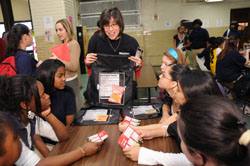School vending machines dole out excess calories, fat
|
Despite efforts to include more healthy choices at schools, standard offerings from vending machines — including fruit juices — are giving students more calories than they need. Recent figures from the HEALTHY Study, a nationwide effort led by Temple University to curb obesity and type 2 diabetes in middle school students, found vending machines beverages had added sugars, high calorie 100 percent fruit juices, and snacks over 200 hundred calories. The data will be presented at The Obesity Society’s annual meeting in early October. “Contrary to common belief, fruit juice is not a healthy snack, if drunk in excess. It should be limited to about six ounces per day, but it’s common to see more than one serving in a bottle,” said Amy Virus, R.D., L.D.N., senior health services coordinator for the HEALTHY Study from the Center for Obesity Research and Education at Temple University. “Changes made to the vending machines in schools will help reduce excess calories taken in by school kids,” she said Data from 42 schools from seven cities showed 75 percent of them had vending |
 Photo by Kelly & Massa
CORE's Sara Solomon (center) educates middle school students on the nutritional value of a bag of chips, the kind often found in school vending machines, as part of the HEALTHY Study. Figures from the study presented at the Obesity Society's annual meeting found that vending machines' snacks can offer up to 480 calories per item.
|
|
machines. Of those machines, 83 percent sold beverages only and 17 percent sold snack foods only. The most prevalent beverages available in vending machines were added-sugar beverages (39 percent) and 100 percent fruit juice (23 percent). The most prevalent snacks available were reduced fat chips (22 percent), regular baked goods (16 percent), cereal bars (14 percent) and low fat ice cream (14 percent). Nutritional content was also collected for all of the items. Overall, the energy content of beverages ranged from zero calories for water and 325 calories for added sugar drinks, and snacks were between 25 calories for low fat ice cream item to 480 calories for baked goods. “The program’s goal is to ultimately remove all juice and sugar added beverages, offer water instead and eliminate candy from vending machines,” said Virus, who is also president of the Pennsylvania Dietetic Association. As a starting point, the HEALTHY study has set a limit of 200 calories for vending machine snacks for its participating schools. In addition, the program also plans to improve the total food environment, including cafeteria meals, a la carte, vending machines and student stores. The study also includes physical education and health classes. Funding for the study was provided by National Institutes of Health (NIH). Other presenters are Stella Volpe, Diane Stadler, Jill Hartstein, Laure El Ghormli, Connie Mobley —Written by Anna Nguyen |
|